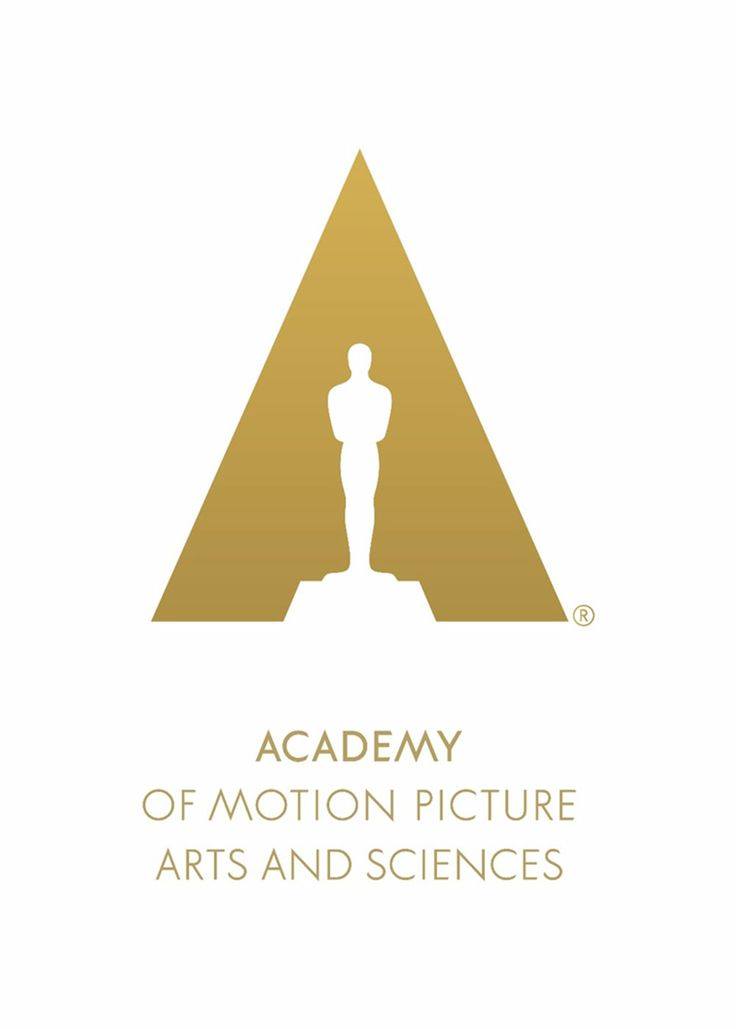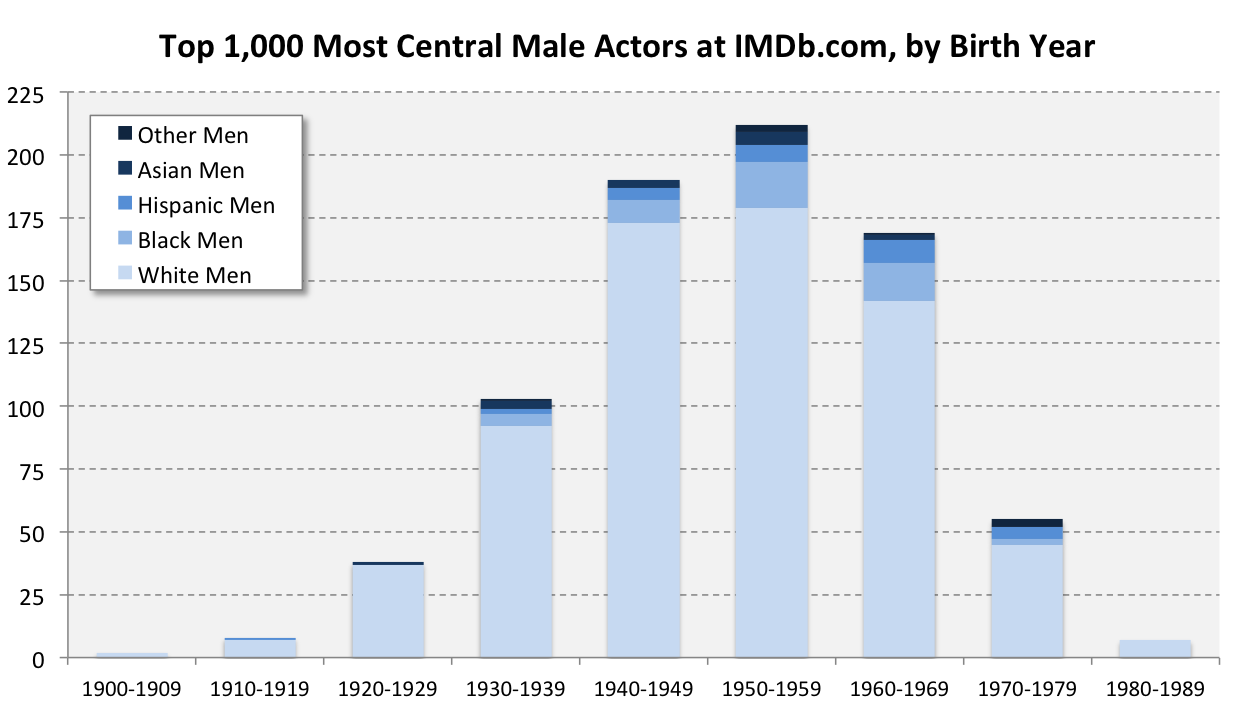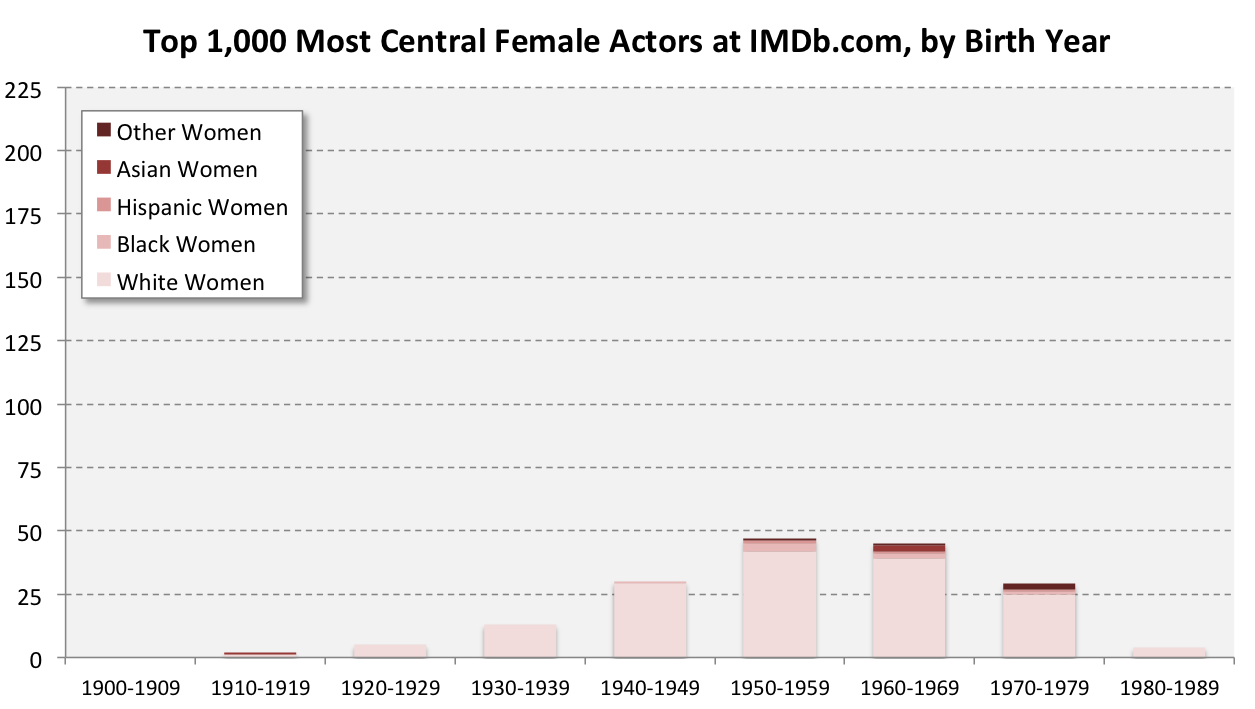 The 2016 Oscar nominations were just announced. This is the second year in a row that all 20 acting nominees are white–prompting the hashtag #OscarsSoWhite. Matthew Hughey wrote on this issue last year as well. The announcement got me thinking about inequality in film. The nominees are selected by just over 7,000 members of the Academy of Motion Picture Arts and Sciences–so they are elected by a panel of peers. But members of the AMPAS are not automatically voting members. You have to apply, and your application has to be sponsored by existing member of the branch of the Academy for which you would like to be considered (here). So, while the Oscars are awarded by a panel of peers, who make up the list of people who qualify as “peers” in the first place is a political matter. And just like anywhere else, knowing someone who knows someone likely plays a role in gaining access.
The 2016 Oscar nominations were just announced. This is the second year in a row that all 20 acting nominees are white–prompting the hashtag #OscarsSoWhite. Matthew Hughey wrote on this issue last year as well. The announcement got me thinking about inequality in film. The nominees are selected by just over 7,000 members of the Academy of Motion Picture Arts and Sciences–so they are elected by a panel of peers. But members of the AMPAS are not automatically voting members. You have to apply, and your application has to be sponsored by existing member of the branch of the Academy for which you would like to be considered (here). So, while the Oscars are awarded by a panel of peers, who make up the list of people who qualify as “peers” in the first place is a political matter. And just like anywhere else, knowing someone who knows someone likely plays a role in gaining access.
Sociologists who study networks are often interested in how social networks provide access to various things people might want to acquire (wealth, status, access, “success” more generally, etc.). This is why we have a concept for just how networked you are: “social capital.” And certainly lots of people are complaining about the fact that Hollywood is an old, white, boy’s club and attempting to change this. Indeed, Genna Davis founded an institute to study gender in the media. April Reign (an editor at Broadway Black and NU Tribe Magazine) founded the hashtag #OscarsSoWhite after the all-white slate of nominees were announced last year. And Maureen Dowd of The New York Times wrote an extensive article last year on the entrenched sexism that keeps women from occupying central roles in Hollywood. Jessica Piven, one of directors quoted in the article, said:
“I feel that there is something going on underneath all of this which is the idea that women aren’t quite as interesting as men. That men have heroic lives, do heroic things, are these kind of warriors in the world, and that women have a certain set of rooms that they have to operate in.”
This belief system results in a network saturated with men and with precious few opportunities for women–and even fewer for women of color. And as Effie Brown’s interaction with Matt Damon in “Project Greenlight” brought up, conversations about challenging the lack of diversity in Hollywood (similar to challenging the lack of diversity elsewhere) are often met with the presumption that diversity means compromising on ability, talent and creativity. Entrenched sexism and inequality is a struggle to challenge in any institution because… well, because it’s entrenched. So, it’s easy to feel like the most qualified guy who just happens to also be white without fully appreciating the fact that being a white guy might have been a big part of what gave you a foot in the door in the first place.
To think about this empirically, consider the party game “Six Degrees of Kevin Bacon”. The idea plays on the theory of “six degrees of separation”—part of a sociological puzzle called the “small world problem” asking just how connected everyone in the world is to everyone else. The theory suggests that we are no more than six connections away from anyone in the world. In the early 1990s, some students at Albright University came up with the idea for the game: pick any actor and see if you can connect that actor with Kevin Bacon through shared movie appearances with other actors as the connections. Take Angela Bassett for example. Angela Bassett was in Sunshine State (2002) with Charlayne Woodard who was in He Said, She Said (1991) with… Kevin Bacon. So, Angela Bassett has a Bacon number of 2.
Later, a group of computer science students at the University of Virginia produced the network of actors to see how “central” Kevin Bacon actually is using IMDB.com (you can play around with the network on their site, www.oracleofbacon.org). And, as it turns out, Kevin Bacon is a central actor—he’s been in films with over 3,000 other actors and more than 99% of all of the almost 2 million actors listed on IMDB.com can be connected with Kevin Bacon in 5 connections or less. But, he’s not the most central actor. He’s actually the 411th most centrally connected actor (you can see the top 1,000 most “central” actors here). But, Kevin Bacon does share some things in common with the most central actor (Eric Roberts): they’re both white, they’re both men, and they were both born within two years of each other. Coincidence?
When I encountered the list, I noticed that there weren’t many women. There are only 3 in the top 100 most central actors. And all three are white. So, I wrote a script to data mine some basic information on the top 1,000 to see who they are using data from IMDB.com (birth year) as well as NNDB.com (which lists race and gender).* The list, perhaps unsurprisingly, is dominated by men (81.75%) and by white people (87.8%). Below is the breakdown for proportions of actors among the top 1,000 most central actor by gender and race. It’s a powerful way of saying that Hollywood continues to be a (white) boy’s club. But they’re also an old white boy’s club as well. I also collected data on birth year. And while the 50’s were the best decade to be born in if you want to be among the 1,000 most “central” actors today, the data for the men skews a bit older.** This lends support to the claim that men do not struggle to find roles as much as women do as they age–which may also support the claim that there are more complex roles available to men (as a group) than women.
It’s a powerful way of saying that Hollywood continues to be a (white) boy’s club. But they’re also an old white boy’s club as well. I also collected data on birth year. And while the 50’s were the best decade to be born in if you want to be among the 1,000 most “central” actors today, the data for the men skews a bit older.** This lends support to the claim that men do not struggle to find roles as much as women do as they age–which may also support the claim that there are more complex roles available to men (as a group) than women.
 The other things I noticed quickly were that: (1) Hispanic and Asian men among the top 1,000 actors list are extremely likely to be typecast as racial stereotypes, and (2) there are more multiracial women among the top 1,000 actors than either Hispanic or Asian women.
The other things I noticed quickly were that: (1) Hispanic and Asian men among the top 1,000 actors list are extremely likely to be typecast as racial stereotypes, and (2) there are more multiracial women among the top 1,000 actors than either Hispanic or Asian women.
Part of what this tells us is that we like to watch movies about white people and men… white men mostly. But part of why we like these movies is that these are the movies in which people are investing and that get produced. As a result of this, there are a critical mass of super-connected white men in Hollywood. So, it shouldn’t surprise us that white actors dominate the Oscar nominations. They’ve been hoarding social capital in the industry since it began. #OscarsSoWhite
_________________________________
* To get the data, I wrote a Python script using the Unofficial IMDb API and the NNDB.com’s API. The results were able to read data for gender for all 1,000 people on the list but only gender, birth year, and race for 959 of the 1,000 people in the dataset. The other 41 had incomplete information on both sites. And I didn’t bother to clean the data up any more.
**Part of becoming a more central actor in the network of all actors has to do with having been a part of a mass of filmed projects with a variety of different actors. The most central actor – Eric Roberts – has worked on projects with more than 8,000 other actors over the course of his career. And being alive longer (perhaps obviously) helps. But, it’s not all older actors. And you don’t have to be living to be on this list. But, actors born in the 1920’s, 30’s, and 40’s aren’t as central (as decade-based groups). So, some of this is also having been in your 20’s, 30’s and 40’s between 1970 and 1990 which was a big period of growth for Hollywood.

Comments 2
Helana Darwin — January 21, 2016
Tristan Bridges, you're on fire
Mindy Fried — January 21, 2016
Fantastic, Tristan! Tx... Will share!